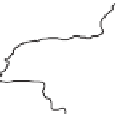Geology Reference
In-Depth Information
factories in different palaeoceanographic,
palaeoclimatological and palaeoecological set-
tings have been discussed by Schlager (2003) and
Mutti & Hallock (2003). Wright & Burgess (2005)
acknowledge the high temporal and spatial vari-
ability of depositional environments that leads to
facies mosaics, which correspond better to real-
ity than the linear arrangement of facies belts as
shown in many models. For the Holocene, many
examples of facies mosaics have been published:
Gischler & Lomando (1999) documented the high
complexity of facies distribution of isolated car-
bonate platforms in Belize; Riegl & Piller (1999)
mapped the great lateral variability of coral car-
pets, reefs, and carbonate sand in Safaga Bay
(Egypt); and Rankey (2002) discussed the frac-
tal nature of facies patches on the tidal fl ats of
Andros Island (Bahamas). However, despite the
ever more detailed studies of recent and ancient
carbonate facies and the undeniable progress in
the understanding of shallow-water carbonate
systems, there is still a discrepancy in the space
and time resolution between the interpretations of
ancient and modern depositional environments.
This is a result of the diffi culty in obtaining con-
tinuous, three-dimensional information on facies
and sedimentary structures in ancient carbon-
ates, and from the diffi culty of defi ning a precise
time-frame that allows reconstructing isochronous
depositional surfaces in the rock record.
In this paper a case study is presented where
the evolution of carbonate facies through space
and time is monitored with a time resolution of
10-20 kyr. This allows for a realistic evaluation of
the controlling parameters such as sea-level and
climate changes.
Germany
France
Austria
Vorbourg
Bern
Switzerland
Delèmont
Italy
Hautes-
Roches
Moutier
Saignelegier
Court
France
N
Tavannes
Tramelan
10 km
St-Imier
Biel
Savagnières
La Chaux-
de-Fonds
Pertuis
Le Locle
Fig. 3.
Location of the fi ve studied sections in the Swiss
Jura Mountains. Solid lines are roads, dashed line is the
Swiss-French border.
Biostratigraphy
ammonite
Cyclo-
stratigraphy
Chrono-
stratigraphy
Lithostratigraphy
(members)
Sequence-
stratigraphy
zones subzones
400-100 kyr
Ox8
154.63
154.63
La May
hauffianum
Bure /
Oolithe rousse
Hauptmumienbank /
Steinebach
bimammatum
Ox7
155.15
berrense
?
semi-
mammatum
155.68
Ox6
Günsberg /
Röschenz
grossouvrei
155.81
stenocycloides
156.20
rotoides
Vorbourg
schilli
Fig. 4.
Stratigraphic framework of the sections studied.
A high-resolution analysis is presented for the interval
marked in grey (Fig. 9). Chrono-, bio- and sequence stratig-
raphy based on Hardenbol
et al
. (1998), lithostratigraphy
according to Gygi (1995), cyclostratigraphy according to
Pittet (1996), Pittet & Strasser (1998) and Hug (2003).
STUDIED SECTIONS,
PALAEOGEOGRAPHY AND
STRATIGRAPHY
The Oxfordian mixed carbonate-siliciclastic sedi-
mentary succession in the Swiss Jura Mountains
has been studied extensively over the past few
decades (Ziegler, 1956; Bolliger & Burri, 1970;
Gygi, 1986, 1995; Gygi & Persoz, 1986; Pittet, 1996;
Dupraz, 1999; Hug, 2003; Védrine, 2007). For the
present work, fi ve sections were selected (Fig. 3)
focusing on the uppermost part of the Günsberg
and Röschenz members and the lower part of
the Hauptmumienbank and Steinebach members
(Fig. 4). The sections were logged along road cuts in
the cases of Pertuis, Savagnières, Gorges de Court
and Vorbourg, and along an abandoned forestry
path in the case of Hautes-Roches. Unfortunately,
outcrop conditions did not allow the strata to be
followed laterally over more than a few metres,
and the sections are widely spaced. The facies
analysis is based on continuous outcrop observa-
tion with a hand lens and on 433 thin-sections
and marl washings (Védrine, 2007). Particular
attention was paid to bedding surfaces in order
to distinguish between hardgrounds, fi rmgrounds
and erosion surfaces.

































































































